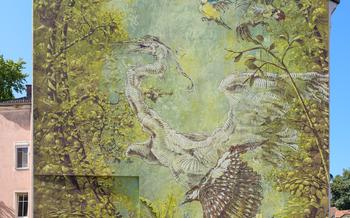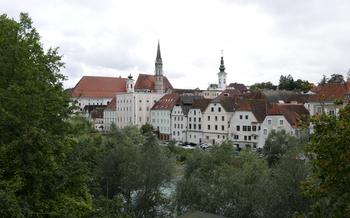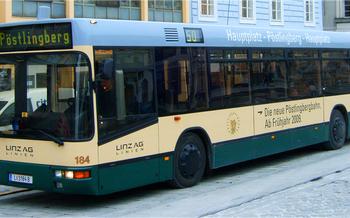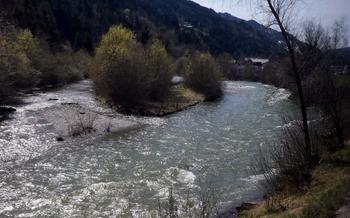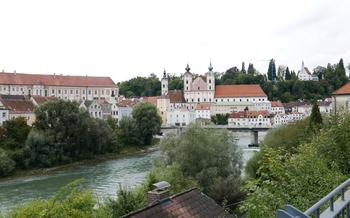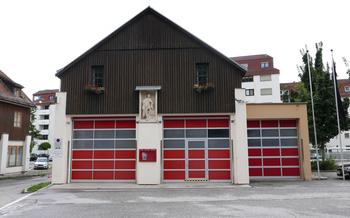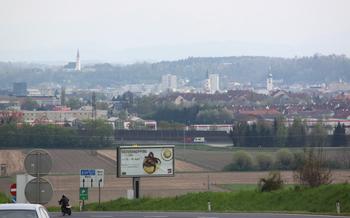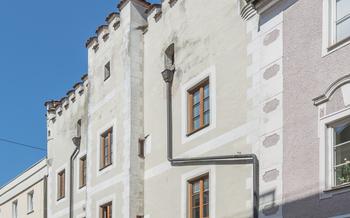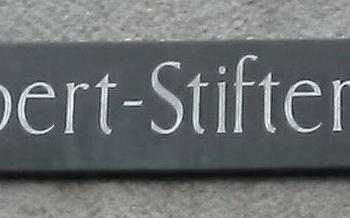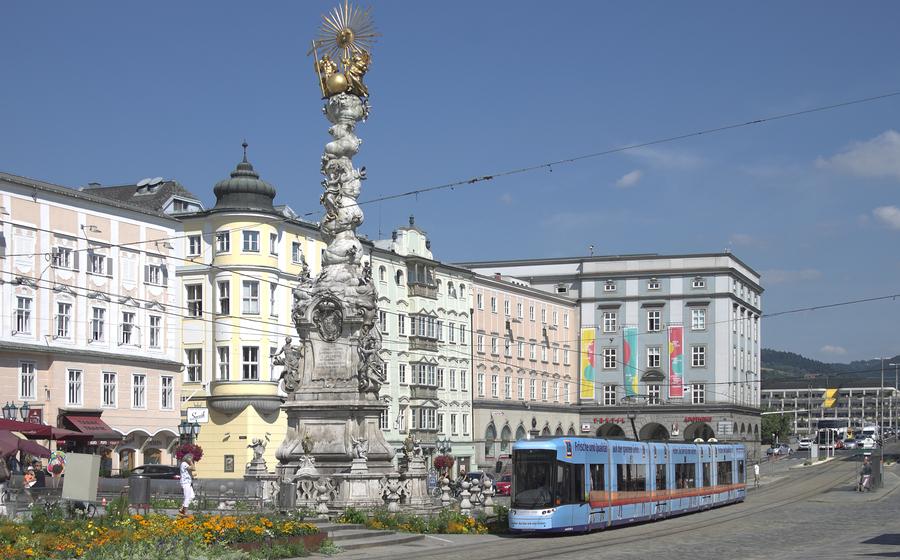
Kremsmünster Abbey Treasury (near Linz)
- A Journey Through History: The Abbey’s Rich Past
- Architectural Masterpieces: The Abbey Buildings
- Treasures Unveiled: The Treasury’s Highlights
- A Glimpse into Monastic Life: The Abbey Museum
- Heavenly Melodies: The Abbey’s Music Heritage
- Exploring the Abbey Grounds: A Serene Oasis
- Events and Festivals: Celebrating Kremsmünster’s Traditions
- Local Delights: Savoring Kremsmünster’s Cuisine
- Beyond the Abbey: Exploring the Region
- Practical Tips for Visitors: Planning Your Visit
- Dress Code and Etiquette: Showing Respect
- Souvenirs and Mementos: Taking a Piece of Kremsmünster Home
- Insider Tip: Hidden Gem in the Library
A Journey Through History: The Abbey’s Rich Past
Kremsmünster Abbey's story stretches back over 12 centuries, intertwining with the tapestry of European and Austrian history. Its foundation in 777 AD by Duke Tassilo III of Bavaria marked the beginning of a Benedictine monastery that would become a beacon of learning, culture, and spirituality.
In the Middle Ages, the abbey flourished as a center of education and scholarship. Its renowned scriptorium produced illuminated manuscripts that are now treasured artifacts, preserving knowledge and artistic heritage for generations to come. The monks' dedication to education extended beyond the abbey walls, as they established schools that contributed to the region's intellectual growth.
During the Baroque era, the abbey underwent a transformative reconstruction, embracing the exuberant style that characterized the period. In the 17th and 18th centuries, the abbey's buildings were adorned with elaborate frescoes, stucco work, and intricate sculptures, reflecting the prevailing artistic and cultural trends.
Throughout its history, Kremsmünster Abbey has played a pivotal role in shaping the region's identity. It has served as a spiritual and cultural center, contributing to Upper Austria's rich heritage. The abbey's enduring legacy continues to inspire visitors and pilgrims alike, who come to marvel at its architectural splendor and delve into its captivating history.
Architectural Masterpieces: The Abbey Buildings
The architectural ensemble of Kremsmünster Abbey is a testament to the artistic and spiritual heritage of the Benedictine monks. The abbey church, built in the Baroque style, stands as a masterpiece of sacred architecture. Its imposing facade is adorned with intricate carvings and sculptures, while the interior boasts stunning frescoes and stucco work. The high altar, a masterpiece of Baroque craftsmanship, is a focal point of the church.
The abbey library, housing a vast collection of rare books and manuscripts, is another architectural gem. The library hall, with its soaring ceiling and elegant furnishings, provides a serene and conducive atmosphere for study and contemplation. The Wandelhalle, a beautiful arcaded courtyard with a Renaissance fountain, offers a tranquil space for visitors to relax and admire the surrounding architecture.
The abbey's buildings, with their harmonious blend of Baroque and Renaissance elements, reflect the cultural and spiritual significance of this centuries-old institution. They stand as a testament to the enduring legacy of the Benedictine monks and their dedication to learning, faith, and community.
Treasures Unveiled: The Treasury’s Highlights
The Kremsmünster Abbey Treasury is home to a dazzling array of religious and historical treasures, each with its own unique story and significance. Among the highlights of the collection are the exquisite Tassilo Chalice, a masterpiece of goldsmith work crafted in the 8th century. Its intricate engravings depict scenes from the life of Christ and the saints, making it a testament to the skill and artistry of early medieval craftsmen.
Another must-see treasure is the Golden Madonna, a stunning Gothic sculpture dating from the 14th century. The life-size statue depicts the Virgin Mary holding the infant Jesus, and its intricate details and delicate features are a testament to the sculptor’s mastery. Equally impressive is the reliquary of Saint Victoria, a lavishly decorated container that holds the remains of the saint. Crafted in the 12th century, the reliquary is adorned with precious stones, enamel, and intricate goldsmith work, showcasing the exceptional craftsmanship of the period.
In addition to these highlights, the treasury also houses a number of other notable treasures, including the Imperial Crown of the Holy Roman Empire, a symbol of power and authority that was used during imperial coronations. The Codex Aureus, an illuminated manuscript from the 9th century, is a testament to the abbey’s rich literary heritage. Finally, the Kremsmünster Mappa Mundi, a 13th-century world map, offers a fascinating glimpse into medieval perceptions of the world.
A Glimpse into Monastic Life: The Abbey Museum
Step into the Abbey Museum and delve into the captivating world of the Benedictine monks who have called Kremsmünster home for over 12 centuries. Through engaging exhibits and interactive displays, the museum unveils the rich history, culture, and daily life of these dedicated individuals.
Discover artifacts that showcase the abbey’s educational pursuits, from ancient manuscripts and scientific instruments to intricate works of art. Learn about the monks’ spiritual practices and traditions through displays of religious objects, vestments, and liturgical books. Explore the economic activities that sustained the abbey, including agriculture, forestry, and trade.
Multimedia presentations and interactive exhibits bring the past to life, offering visitors a deeper understanding of the monastic way of life. Experience the rhythm of the monks’ daily routine, from prayer and meditation to work and study. Gain insights into their contributions to the intellectual, cultural, and spiritual development of the region.
The Abbey Museum offers a unique opportunity to step back in time and immerse yourself in the fascinating world of the Benedictine monks. It’s a journey that will leave you inspired and enriched, with a newfound appreciation for the enduring legacy of Kremsmünster Abbey.
Heavenly Melodies: The Abbey’s Music Heritage
Kremsmünster Abbey boasts a rich musical heritage that dates back centuries. The Benedictine monks have a long tradition of music and choral singing, and the abbey's music school, founded in the 12th century, is one of the oldest in Europe. The renowned boys' choir, the Kremsmünsterer Sängerknaben, performs regularly in the abbey church, delighting audiences with their angelic voices. Throughout the year, the abbey hosts concerts, recitals, and music festivals, showcasing a variety of musical genres from classical to contemporary. Visitors can attend these events to experience the abbey's vibrant musical culture firsthand and enjoy the beautiful acoustics of the abbey church.
Exploring the Abbey Grounds: A Serene Oasis
Nestled amidst the serene landscapes of Upper Austria, the Kremsmünster Abbey boasts beautifully landscaped gardens that offer a tranquil retreat for visitors seeking solace and inspiration. Ornate fountains, meticulously sculpted statues, and vibrant flower beds adorn the grounds, creating a visual feast that delights the senses. The tranquil atmosphere invites visitors to stroll leisurely along the winding paths, immersing themselves in the beauty of nature and the serenity of the surroundings. Whether seeking a moment of contemplation or simply enjoying the fresh air, the abbey gardens provide a sanctuary of peace and tranquility for all who visit.
Events and Festivals: Celebrating Kremsmünster’s Traditions
Kremsmünster Abbey's rich traditions are celebrated throughout the year with a variety of events and festivals. The annual Kremsmünster Abbey Festival, held in the summer, is a highlight of the cultural calendar. This festival showcases classical music concerts, theater performances, and exhibitions, attracting visitors from across the region.
During the festive season, the Advent and Christmas markets transform the abbey grounds into a magical winter wonderland. Local crafts, mulled wine, and traditional treats fill the air, creating a warm and welcoming atmosphere. Visitors can browse the stalls for unique gifts and souvenirs while enjoying the festive cheer.
Organ concerts and recitals are held regularly in the abbey church, showcasing the talents of the abbey's renowned musicians. These concerts offer a unique opportunity to experience the abbey's impressive acoustics and immerse yourself in beautiful music.
Throughout the year, special events and workshops are organized at the abbey, providing visitors with an in-depth look into the abbey's history, culture, and traditions. These events may include guided tours, lectures, workshops, and exhibitions, offering a chance to learn more about the abbey's significance and its role in the community.
Local Delights: Savoring Kremsmünster’s Cuisine
Kremsmünster offers a culinary adventure that harmonizes traditional Austrian cuisine with the region's unique flavors. Fresh, locally sourced ingredients take center stage, creating dishes that celebrate the bounty of Upper Austria.
Indulge in tafelspitz, a classic boiled beef dish served with horseradish sauce, chives, and roasted potatoes. Wiener schnitzel, a beloved Austrian specialty, features a thin, breaded cutlet of veal fried to golden perfection. Käsespätzle, a delightful pasta dish, combines tender spaetzle with melted cheese and crispy onions.
Accompany your meal with a glass of local wine from the Traunsee region, known for its crisp whites and fruity reds. Kremsmünster's breweries offer a selection of refreshing beers, crafted with pure Alpine water and traditional brewing techniques.
For a sweet treat, sample the Linzer torte, a delicate pastry filled with red currant jam and topped with a lattice crust. The town's cafés and bakeries are havens for dessert enthusiasts, offering an array of tempting cakes, pastries, and chocolates.
Whether you savor a hearty meal at a traditional Gasthaus or opt for a leisurely coffee and cake break, Kremsmünster's culinary scene promises an unforgettable gastronomic experience.
Beyond the Abbey: Exploring the Region
Kremsmünster serves as an ideal base for exploring the diverse attractions of Upper Austria. The vibrant city of Linz, the capital of the province, is just a short distance away and offers a wealth of cultural and historical experiences. Visitors can admire the stunning architecture of the Old Town, explore the Ars Electronica Center for art, technology, and society, or take a leisurely stroll along the Danube River.
For those seeking natural beauty, the Salzkammergut lake district, with its crystal-clear lakes and picturesque towns, is a must-visit. The Dachstein Glacier, part of the Dachstein massif, provides opportunities for hiking, skiing, and breathtaking views of the surrounding Alps.
The region offers a variety of outdoor activities for adventure enthusiasts. Hiking trails wind through lush forests and meadows, while bike paths traverse the scenic countryside. Swimming and boating are popular pastimes in the many lakes and rivers. In the winter, the Dachstein Glacier transforms into a winter sports paradise, with skiing, snowboarding, and cross-country skiing opportunities.
Day trips and excursions to other cultural and historical sites in the region are easily arranged from Kremsmünster. The nearby towns of Steyr and Gmunden boast well-preserved medieval centers and charming architecture. The Benedictine monastery of Admont, with its impressive library and stunning architecture, is another popular destination.
Exploring the region beyond Kremsmünster Abbey allows visitors to immerse themselves in the rich history, culture, and natural beauty of Upper Austria, creating a truly memorable and enriching travel experience.
Practical Tips for Visitors: Planning Your Visit
To make the most of your visit to Kremsmünster Abbey, here are some practical tips to help you plan your trip:
-
Best time to visit: Spring or summer offers pleasant weather for exploring the abbey and its surroundings.
-
Guided tours: The abbey treasury and museum offer guided tours in English, providing insights into the history and significance of the collections.
-
Combination tickets: Save money by purchasing a combination ticket that includes admission to multiple attractions, such as the abbey, treasury, and museum.
-
Accessibility: While most areas of the abbey are accessible to visitors with disabilities, some areas may have limited accessibility due to historical preservation considerations.
-
Dress code: When visiting the abbey, appropriate attire is recommended, such as modest clothing that covers shoulders and knees.
-
Etiquette: Silence and reverence should be observed in the abbey church and library. Photography is generally not permitted inside the abbey buildings, but exceptions may be granted for specific purposes.
-
Souvenirs: The abbey shop offers a variety of souvenirs, including books, postcards, and religious items. Local crafts and products can be found at the Kremsmünster farmers’ market.
-
Insider tip: Don’t miss the 9th-century Codex Millenarius, one of the oldest surviving manuscripts in Austria. Ask a librarian to show you this unique treasure.
Dress Code and Etiquette: Showing Respect
When visiting Kremsmünster Abbey, it is important to dress appropriately and observe proper etiquette to show respect for the sacred and historic nature of the site. Visitors should opt for modest and conservative attire that covers their shoulders and knees. Shorts, tank tops, and revealing clothing are not suitable.
Inside the abbey church and library, silence and reverence should be maintained. Refrain from loud conversations, laughter, or any behavior that may disturb the peaceful atmosphere. Photography is generally not permitted inside the abbey buildings, as it can be disruptive and disrespectful. Please respect these guidelines to ensure a harmonious and respectful visit for all.
Souvenirs and Mementos: Taking a Piece of Kremsmünster Home
As you bid farewell to Kremsmünster, don't forget to take a piece of its charm with you. The abbey shop, located within the abbey complex, offers a delightful array of souvenirs that will serve as lasting mementos of your visit. From beautifully illustrated books and postcards depicting the abbey's architectural wonders to an assortment of religious items that carry the spirit of the Benedictine monks, you'll find something to suit every taste and budget.
For a more authentic experience, venture to the Kremsmünster farmers' market, where local artisans and vendors showcase their handmade crafts and regional products. Here, you can pick up unique souvenirs such as hand-carved wooden ornaments, intricate lacework, and colorful pottery. Treat your taste buds to locally produced honey, jams, and freshly baked pastries, all infused with the flavors of the region.
And if you're looking for a truly special memento, consider taking home a bottle of local wine or beer. The Kremsmünster region is home to several vineyards and breweries that produce exquisite wines and craft beers using traditional methods and local ingredients. Whether you prefer a crisp white wine, a robust red wine, or a refreshing beer, you'll find the perfect souvenir to remind you of your time in Kremsmünster and its surrounding countryside.
Insider Tip: Hidden Gem in the Library
While exploring the abbey library, be sure to ask a librarian to show you the Codex Millenarius, a hidden gem among the vast collection. This 9th-century manuscript is one of the oldest surviving manuscripts in Austria, containing valuable historical and cultural information. The beautifully illuminated pages offer a glimpse into the region's rich past and the abbey's role in preserving knowledge throughout the centuries. Don't miss this unique opportunity to see firsthand this remarkable treasure that lies within the walls of Kremsmünster Abbey.
